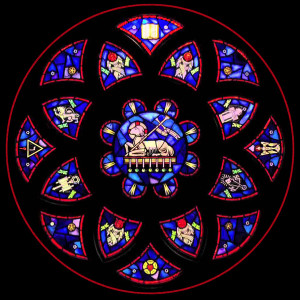This is an interesting Christian Mandala. The basic structure is composed completely out of circles. Eight overlapping outer circles surrounding one slightly larger inner circle. This is the stained glass window in Eastvold Chapel on the campus of Pacific Lutheran University.
The window was designed by Jesse Pflueger, a religion professor, and dedicated in the early 1950’s. This is a nice piece of work and has some interesting elements.
We start at the center which has an Agnus Dei (Lamb of God) symbol for Christ. It is common to find Christ in the center of a Christian mandala.
Recall that the Agnus Dei in the Stanford mandala has the lamb standing together with a cross and banner representing the risen Christ. The Agnus Dei at the center of the PLU mandala has a cross and banner, but the lamb is seated on what looks like a closed book with seven small circles hanging from the book. This symbol has a different meaning.
The seven small circles associated with the book are seven seals. The seated Agnus Dei on the closed book with seven seals is the symbol used for the final judgments by Christ as described in the book of Revelation. This is a change in the role of Christ. He came first as a humble servant and redeemer, but is represented here as taking on the role of the judge of mankind.
In the 1950’s chapel became mandatory at PLU. In addition, students had assigned seats. Put this together with the final set of judgments symbolism and one concludes that the PLU Student body of the 1950’s was in need of an intense Spiritual Intervention.
I am kidding, but still I wonder. Why did Professor Pflueger introduce this symbolism? Young adults away from home for the first time? Historical events such as the use of the atomic bomb in 1945, or the formation of the State of Israel in 1948? I don’t know.
In Part 4B and onward we will take a look at the symbols surrounding the center circle. Some are common Christian symbols that we saw previously in the Stanford mandala, others are a bit unusual referring to Old Testament prophets.

